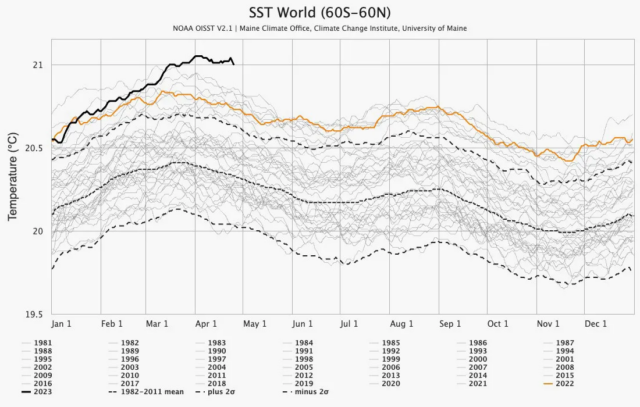To call what is happening in the oceans an anomaly is a bit of an understatement. Average sea surface temperatures have dropped since March climbed to record heightsas shown in the dark line in the chart below.

Sean Birkel/University of Maine
Since this record began in the early 1980s — the other squiggly lines are prior years — the global average for the world’s ocean surfaces has fluctuated seasonally between 19.7° and 21° Celsius (67.5° and 69.8° Fahrenheit ). At the end of March, the average shot above 21° and stayed there for a month. (The most recent reading, for April 26, was just a hair below 21°.) This temperature spike is not only unprecedented, but also extreme.
“I’m surprised we’re so far off track,” said Robert Rohde, chief scientist at Berkeley Earth, a nonprofit organization that collects climate data. “Usually when you have a certain warm-up, we beat the previous record by a little bit. At the moment, we have been well above the previous records for this time of year for quite some time.”

Rohde points out that temperatures this week were just under two-tenths of a degree warmer than the previous record. “Two-tenths doesn’t sound like a lot, but in terms of the ocean, two-tenths is actually a lot because it’s not warming as fast as the land,” he says.
As you can see from the chart of recent years, March is normally the beginning of the average sea surface temperature decreasing. That’s because the Southern Hemisphere has transitioned from summer to fall — and that hemisphere has more ocean coverage than the Northern Hemisphere, which has more sizable land masses. As the southern oceans cool, they lower the average global sea surface temperature.
But right now, temperature anomalies are widespread in the world’s oceans. (That near-real-time data comes from a network of satellites, buoys, and other ocean instruments.) “It’s above-average temperatures almost everywhere,” says Rohde. “And there is a significant heat wave in the North Pacific that has been going on for many months.”

